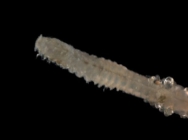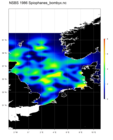BeRMS taxon details
Spiophanes bombyx (Claparède, 1870)
131187 (urn:lsid:marinespecies.org:taxname:131187)
accepted
Species
Spio bombyx Claparède, 1870 · unaccepted (superseded original combination)
marine, brackish, fresh, terrestrial
recent only
(of Spio bombyx Claparède, 1870) Claparède, Édouard. (1870). Les Annélides Chétopodes du Golfe de Naples. Supplément. <em>Mémoires de la Société de physique et d'histoire naturelle de Genève.</em> 20(2): 365-542 [separate pagination at page top, continuous pagination at bottom]., available online at https://biodiversitylibrary.org/page/2094031
page(s): 485-487, plate XII fig. 2 [details]
page(s): 485-487, plate XII fig. 2 [details]
Type locality contained in Gulf of Naples (Italy)
type locality contained in Gulf of Naples (Italy) [from synonym] [view taxon] [details]
Read, G.; Fauchald, K. (Ed.) (2024). World Polychaeta Database. Spiophanes bombyx (Claparède, 1870). Accessed through: VLIZ Belgian Marine Species Consortium (2010 onwards) Belgian Register of Marine Species at: https://www.marinespecies.org/berms/aphia.php?p=taxdetails&id=131187 on 2024-04-19
VLIZ Belgian Marine Species Consortium (2010 onwards). Belgian Register of Marine Species. Spiophanes bombyx (Claparède, 1870). Accessed at: https://marinespecies.org/berms/aphia.php?p=taxdetails&id=131187 on 2024-04-19
Date
action
by
![]() The webpage text is licensed under a Creative Commons Attribution 4.0 License
The webpage text is licensed under a Creative Commons Attribution 4.0 License
original description
(of Spio bombyx Claparède, 1870) Claparède, Édouard. (1870). Les Annélides Chétopodes du Golfe de Naples. Supplément. <em>Mémoires de la Société de physique et d'histoire naturelle de Genève.</em> 20(2): 365-542 [separate pagination at page top, continuous pagination at bottom]., available online at https://biodiversitylibrary.org/page/2094031
page(s): 485-487, plate XII fig. 2 [details]
context source (Deepsea) Intergovernmental Oceanographic Commission (IOC) of UNESCO. The Ocean Biogeographic Information System (OBIS), available online at http://www.iobis.org/ [details]
context source (HKRMS) Shin, P. K. S. (1998). Biodiversity of subtidal benthic polychaetes in Hong Kong coastal waters. In: Proceedings of the Third International Conference on the Marine Biology of the South China Sea, The Marine Biology of the South China Sea (ed. Morton,B.), PP57-74. Hong Kong University Press, Hong Kong. [details]
context source (Schelde) Maris, T.; Beauchard, O.; Van Damme, S.; Van den Bergh, E.; Wijnhoven, S.; Meire, P. (2013). Referentiematrices en Ecotoopoppervlaktes Annex bij de Evaluatiemethodiek Schelde-estuarium Studie naar “Ecotoopoppervlaktes en intactness index”. <em>Monitor Taskforce Publication Series, 2013-01. NIOZ: Yerseke.</em> 35 pp. (look up in IMIS) [details]
context source (BeRMS 2020) Bio-environmental research group; Institute of Agricultural and Fisheries research (ILVO), Belgium; (2015): Macrobenthos monitoring in function of the Water Framework Directive in the period 2007-2009. [details]
basis of record Bellan, G. (2001). Polychaeta, <i>in</i>: Costello, M.J. <i>et al.</i> (Ed.) (2001). European register of marine species: a check-list of the marine species in Europe and a bibliography of guides to their identification. <em>Collection Patrimoines Naturels.</em> 50: 214-231. (look up in IMIS) [details]
additional source Brunel, P., L. Bosse & G. Lamarche. (1998). Catalogue of the marine invertebrates of the estuary and Gulf of St. Lawrence. <em>Canadian Special Publication of Fisheries and Aquatic Sciences, 126.</em> 405 pp. (look up in IMIS) [details] Available for editors
additional source Pollock, L.W. (1998). A practical guide to the marine animals of northeastern North America. Rutgers University Press. New Brunswick, New Jersey & London. 367 pp., available online at http://books.google.com/books?id=i1AmT31cuR4C [details]
additional source Muller, Y. (2004). Faune et flore du littoral du Nord, du Pas-de-Calais et de la Belgique: inventaire. [Coastal fauna and flora of the Nord, Pas-de-Calais and Belgium: inventory]. <em>Commission Régionale de Biologie Région Nord Pas-de-Calais: France.</em> 307 pp., available online at http://www.vliz.be/imisdocs/publications/145561.pdf [details]
additional source Integrated Taxonomic Information System (ITIS). , available online at http://www.itis.gov [details]
additional source Holtmann, S.E.; Groenewold, A.; Schrader, K.H.M.; Asjes, J.; Craeymeersch, J.A.; Duineveld, G.C.A.; van Bostelen, A.J.; van der Meer, J. (1996). Atlas of the zoobenthos of the Dutch continental shelf. Ministry of Transport, Public Works and Water Management: Rijswijk, The Netherlands. ISBN 90-369-4301-9. 243 pp. (look up in IMIS) [details]
additional source Fauvel, Pierre. (1916). Annélides polychètes des Iles Falkland recueillies par M. Rupert Vallentin Esq<sup>re</sup> (1902-1910). <em>Archives de Zoologie Expérimentale et Générale.</em> 55(10): 417-482, plates VIII-IX., available online at https://www.biodiversitylibrary.org/page/6316033 [details]
additional source Fauvel, P. (1927). Polychètes sédentaires. Addenda aux errantes, Arachiannélides, Myzostomaires. <em>Faune de France Volume 16. Paul Lechevalier. Paris.</em> 1-494., available online at http://www.faunedefrance.org/bibliotheque/docs/P.FAUVEL(FdeFr16)Polychetes-sendentaires.pdf [details]
additional source Saint-Joseph, Arthur d'Anthoine de. (1898). Annélides polychètes des côtes de France (Manche et Océan). <em>Annales des Sciences Naturelles, Zoologie et Paléontologie, Paris.</em> Série 8, 5: 209-464, plates XIII-XXIII., available online at https://www.biodiversitylibrary.org/page/35661652
page(s): 352-354, plate XX fig. 165 [details]
additional source Fauchald, K.; Granados-Barba, A.; Solís-Weiss, V. (2009). Polychaeta (Annelida) of the Gulf of Mexico, Pp. 751–788 in D.L. Felder and D.K. Camp (eds.). <em>Gulf of Mexico. Origin, Waters, and Biota. Volume 1, Biodiversity.</em> Texas A&M University Press, College Station, Texas., available online at https://books.google.es/books?id=CphA8hiwaFIC&lpg=PR1&pg=PA751 [details]
additional source Liu, J.Y. [Ruiyu] (ed.). (2008). Checklist of marine biota of China seas. <em>China Science Press.</em> 1267 pp. (look up in IMIS) [details] Available for editors
additional source Trott, T. J. (2004). Cobscook Bay inventory: a historical checklist of marine invertebrates spanning 162 years. <em>Northeastern Naturalist.</em> 11, 261-324., available online at http://www.gulfofmaine.org/kb/files/9793/TROTT-Cobscook%20List.pdf [details] Available for editors
additional source Delgado-Blas, Victor Hugo; Díaz-Díaz, Oscar; Viéitez Martín, José M. (2019). On the diversity of the genus Spiophanes Grube, 1860 (Annelida: Spionidae) in the Spanish peninsular coast, with descriptions of two new species. <em>Cahiers de Biologie Marine.</em> 60(4): 335-351., available online at http://application.sb-roscoff.fr/cbm/article.htm?id=42281
page(s): 340, no figures; note: additional records for Spain [details] Available for editors
redescription Jirkov, I.A. (2001). [Polychaeta of the Arctic Ocean] (In Russian) Polikhety severnogo Ledovitogo Okeana. Yanus-K Press, Moscow, 632 pp., available online at https://www.researchgate.net/publication/259865957_Jirkov_2001_Polychaeta_of_the_North_Polar_Basin [details] Available for editors
redescription Blake, J.A. 1996. Family Spionidae Grube, 1850. pages 81-223. IN: Blake, James A.; Hilbig, Brigitte; and Scott, Paul H. Taxonomic Atlas of the Benthic Fauna of the Santa Maria Basin and Western Santa Barbara Channel. 6 - The Annelida Part 3. Polychaeta: Orbiniidae to Cossuridae. Santa Barbara Museum of Natural History. Santa Barbara [details]
page(s): 485-487, plate XII fig. 2 [details]
context source (Deepsea) Intergovernmental Oceanographic Commission (IOC) of UNESCO. The Ocean Biogeographic Information System (OBIS), available online at http://www.iobis.org/ [details]
context source (HKRMS) Shin, P. K. S. (1998). Biodiversity of subtidal benthic polychaetes in Hong Kong coastal waters. In: Proceedings of the Third International Conference on the Marine Biology of the South China Sea, The Marine Biology of the South China Sea (ed. Morton,B.), PP57-74. Hong Kong University Press, Hong Kong. [details]
context source (Schelde) Maris, T.; Beauchard, O.; Van Damme, S.; Van den Bergh, E.; Wijnhoven, S.; Meire, P. (2013). Referentiematrices en Ecotoopoppervlaktes Annex bij de Evaluatiemethodiek Schelde-estuarium Studie naar “Ecotoopoppervlaktes en intactness index”. <em>Monitor Taskforce Publication Series, 2013-01. NIOZ: Yerseke.</em> 35 pp. (look up in IMIS) [details]
context source (BeRMS 2020) Bio-environmental research group; Institute of Agricultural and Fisheries research (ILVO), Belgium; (2015): Macrobenthos monitoring in function of the Water Framework Directive in the period 2007-2009. [details]
basis of record Bellan, G. (2001). Polychaeta, <i>in</i>: Costello, M.J. <i>et al.</i> (Ed.) (2001). European register of marine species: a check-list of the marine species in Europe and a bibliography of guides to their identification. <em>Collection Patrimoines Naturels.</em> 50: 214-231. (look up in IMIS) [details]
additional source Brunel, P., L. Bosse & G. Lamarche. (1998). Catalogue of the marine invertebrates of the estuary and Gulf of St. Lawrence. <em>Canadian Special Publication of Fisheries and Aquatic Sciences, 126.</em> 405 pp. (look up in IMIS) [details] Available for editors
additional source Pollock, L.W. (1998). A practical guide to the marine animals of northeastern North America. Rutgers University Press. New Brunswick, New Jersey & London. 367 pp., available online at http://books.google.com/books?id=i1AmT31cuR4C [details]
additional source Muller, Y. (2004). Faune et flore du littoral du Nord, du Pas-de-Calais et de la Belgique: inventaire. [Coastal fauna and flora of the Nord, Pas-de-Calais and Belgium: inventory]. <em>Commission Régionale de Biologie Région Nord Pas-de-Calais: France.</em> 307 pp., available online at http://www.vliz.be/imisdocs/publications/145561.pdf [details]
additional source Integrated Taxonomic Information System (ITIS). , available online at http://www.itis.gov [details]
additional source Holtmann, S.E.; Groenewold, A.; Schrader, K.H.M.; Asjes, J.; Craeymeersch, J.A.; Duineveld, G.C.A.; van Bostelen, A.J.; van der Meer, J. (1996). Atlas of the zoobenthos of the Dutch continental shelf. Ministry of Transport, Public Works and Water Management: Rijswijk, The Netherlands. ISBN 90-369-4301-9. 243 pp. (look up in IMIS) [details]
additional source Fauvel, Pierre. (1916). Annélides polychètes des Iles Falkland recueillies par M. Rupert Vallentin Esq<sup>re</sup> (1902-1910). <em>Archives de Zoologie Expérimentale et Générale.</em> 55(10): 417-482, plates VIII-IX., available online at https://www.biodiversitylibrary.org/page/6316033 [details]
additional source Fauvel, P. (1927). Polychètes sédentaires. Addenda aux errantes, Arachiannélides, Myzostomaires. <em>Faune de France Volume 16. Paul Lechevalier. Paris.</em> 1-494., available online at http://www.faunedefrance.org/bibliotheque/docs/P.FAUVEL(FdeFr16)Polychetes-sendentaires.pdf [details]
additional source Saint-Joseph, Arthur d'Anthoine de. (1898). Annélides polychètes des côtes de France (Manche et Océan). <em>Annales des Sciences Naturelles, Zoologie et Paléontologie, Paris.</em> Série 8, 5: 209-464, plates XIII-XXIII., available online at https://www.biodiversitylibrary.org/page/35661652
page(s): 352-354, plate XX fig. 165 [details]
additional source Fauchald, K.; Granados-Barba, A.; Solís-Weiss, V. (2009). Polychaeta (Annelida) of the Gulf of Mexico, Pp. 751–788 in D.L. Felder and D.K. Camp (eds.). <em>Gulf of Mexico. Origin, Waters, and Biota. Volume 1, Biodiversity.</em> Texas A&M University Press, College Station, Texas., available online at https://books.google.es/books?id=CphA8hiwaFIC&lpg=PR1&pg=PA751 [details]
additional source Liu, J.Y. [Ruiyu] (ed.). (2008). Checklist of marine biota of China seas. <em>China Science Press.</em> 1267 pp. (look up in IMIS) [details] Available for editors
additional source Trott, T. J. (2004). Cobscook Bay inventory: a historical checklist of marine invertebrates spanning 162 years. <em>Northeastern Naturalist.</em> 11, 261-324., available online at http://www.gulfofmaine.org/kb/files/9793/TROTT-Cobscook%20List.pdf [details] Available for editors
additional source Delgado-Blas, Victor Hugo; Díaz-Díaz, Oscar; Viéitez Martín, José M. (2019). On the diversity of the genus Spiophanes Grube, 1860 (Annelida: Spionidae) in the Spanish peninsular coast, with descriptions of two new species. <em>Cahiers de Biologie Marine.</em> 60(4): 335-351., available online at http://application.sb-roscoff.fr/cbm/article.htm?id=42281
page(s): 340, no figures; note: additional records for Spain [details] Available for editors
redescription Jirkov, I.A. (2001). [Polychaeta of the Arctic Ocean] (In Russian) Polikhety severnogo Ledovitogo Okeana. Yanus-K Press, Moscow, 632 pp., available online at https://www.researchgate.net/publication/259865957_Jirkov_2001_Polychaeta_of_the_North_Polar_Basin [details] Available for editors
redescription Blake, J.A. 1996. Family Spionidae Grube, 1850. pages 81-223. IN: Blake, James A.; Hilbig, Brigitte; and Scott, Paul H. Taxonomic Atlas of the Benthic Fauna of the Santa Maria Basin and Western Santa Barbara Channel. 6 - The Annelida Part 3. Polychaeta: Orbiniidae to Cossuridae. Santa Barbara Museum of Natural History. Santa Barbara [details]
 Present
Present  Inaccurate
Inaccurate  Introduced: alien
Introduced: alien  Containing type locality
Containing type locality
BIOTIC
Marine Life Information Network - UK
To Barcode of Life (27 barcodes)
To Biodiversity Heritage Library (58 publications)
To Biological Information System for Marine Life (BISMaL)
To European Nucleotide Archive (ENA)
To GenBank (12 nucleotides; 9 proteins)
To Global Biotic Interactions (GloBI)
To PESI
To USNM Invertebrate Zoology Annelida Collection (1214 records)
To ITIS
Marine Life Information Network - UK
To Barcode of Life (27 barcodes)
To Biodiversity Heritage Library (58 publications)
To Biological Information System for Marine Life (BISMaL)
To European Nucleotide Archive (ENA)
To GenBank (12 nucleotides; 9 proteins)
To Global Biotic Interactions (GloBI)
To PESI
To USNM Invertebrate Zoology Annelida Collection (1214 records)
To ITIS


